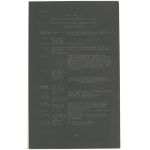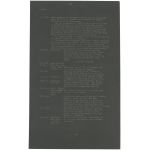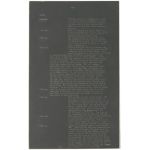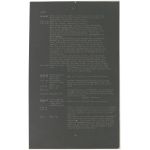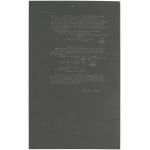English Translation of His Majesty's Submarine U-20 War Diary
1915
Add to Favorites:
Add all page(s) of this document to activity:

Add only page 1 to activity:
Add only page 2 to activity:
Add only page 3 to activity:
Add only page 4 to activity:
Add only page 5 to activity:
Add only page 6 to activity:
Add only page 7 to activity:
This is the English translation of the diary of German Lieutenant Walter Schwieger and his account of the sinking of the Lusitania in 1915. Kapitänleutnant Walter Schwieger was the 30-year-old commander of the submarine U-20 that sank the Lusitania. His war diary describes the attack and the rapid sinking of the ocean liner as he viewed it through his periscope. See the original, untranslated German war diary.
Germany's sinking of the Lusitania was partially responsible for U.S. entry into World War I. The German government had run the following notice in 40 U.S. newspapers on May 1, 1915, ten months after the outbreak of World War I and three months after Germany declared a submarine blockade of the British Isles:
In the context of a wartime crossing, the cargo of the Lusitania on her last voyage included war material for the Allied war effort, including 52 tons of shrapnel shells, more than 3,000 percussion fuses, and 4,200 cases of Remington rifle cartridges.
For more information about this diary see the National Archives online exhibit Eyewitness.
Germany's sinking of the Lusitania was partially responsible for U.S. entry into World War I. The German government had run the following notice in 40 U.S. newspapers on May 1, 1915, ten months after the outbreak of World War I and three months after Germany declared a submarine blockade of the British Isles:
Travellers intending to embark on the Atlantic voyage are reminded that a state of war exists between Germany...and Great Britain...and that travellers sailing in the war zone on ships of Great Britain or her allies do so at their own risk.On that day, the British luxury liner, the RMS Lusitania, set sail from New York for Liverpool. Six days later, on May 7, 1915, twelve miles off the southern coast of Ireland, she was torpedoed by a German submarine and sank. Of the 1,959 people on board, 1,195 died, including more than 120 Americans.
In the context of a wartime crossing, the cargo of the Lusitania on her last voyage included war material for the Allied war effort, including 52 tons of shrapnel shells, more than 3,000 percussion fuses, and 4,200 cases of Remington rifle cartridges.
For more information about this diary see the National Archives online exhibit Eyewitness.
This primary source comes from the Naval Records Collection of the Office of Naval Records and Library.
National Archives Identifier: 833792
Full Citation: English Translation of His Majesty's Submarine U-20 War Diary; 1915; Subject Files, ca. 1924 - ca. 1946; Naval Records Collection of the Office of Naval Records and Library, Record Group 45; National Archives Building, Washington, DC. [Online Version, https://www.docsteach.org/documents/document/english-translation-u20-war-diary, April 27, 2024]Rights: Public Domain, Free of Known Copyright Restrictions. Learn more on our privacy and legal page.




